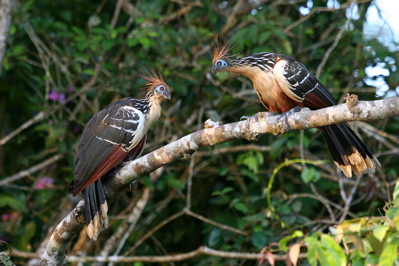
I just arrived from a fantastic International Expeditions (www.ietravel.com) 7-day exploration of the Pacaya and Samiria Reserve, in the heart of the Amazon basin. The biggest wetland in the world! I was the lucky Expedition Leader of 23 great fellow travelers, who knew how to enjoy the gifts of the pristine jungle.
The water level has already rise 50% of what is expected for this year, so we had many creeks to explore while not having the wildlife “too” disperse. Wildlife was abundant, and so where the close encounters with it. Check the photos!
I think this makes a great theme for the first travel post in our Blog. More (Article & Photos) >>>
The Destination:
The Pacaya-Samiria Reserve is located in the heart of the Amazon Basin, right where the Ucayali and Marañon rivers join (For many, the true origin of the Amazon). From that river junction, upstream, the two rivers separate (One towards the east, the other towards south) leaving between them a triangularly shaped, enormous wetland that is the Pacaya-Samiria Reserve. (Well, actually the reserve includes seasonaly flodded forest areas too, but that is a subject for a future post…)
Politically it belongs to Peru, in South America. It was the first natural reserve created by the country and stands as its biggest with 2´080,000 square hectares (Some 5 million acres) being the home of over 400 species of birds, 102 of mammals, 130 of reptiles and amphibians, and countless plants (Some say it might hold some records in flora diversity)
In the reserve many black-water rivers and lakes exist. That is why locals refer to it as the “Jungle of the Mirrors”. The two most important Rivers in it are The Samiria and The Pacaya, thus its name.
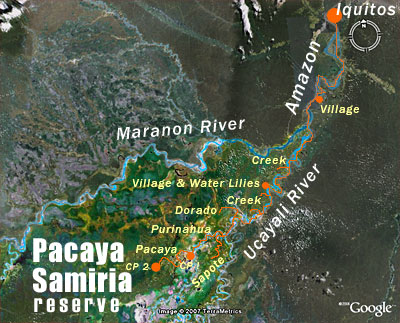
The Expedition’s Objective:
To explore the Ucayali River towards south (Upstream), looking for creeks that cut through the buffer zone into the reserve, until reaching the mouth of the Pacaya River. Once there we would travel as deep as possible into the Pacaya River looking for some of the best wildlife encounters the Amazon Basin can produce.
High on the list of species we wanted to observe where the Hoatzins, Red Howler Monkeys, Monk Saki Monkeys, Rainbow Boa, Three Toed Sloth, Scarlet and Blue-and-Yellow Macaws, Yellow-spotted Turtles, Spectacle Caimans and Giant Water Lilies.
The Adventure:
I met my fellow travelers in Lima. We all enjoyed a detailed city tour with Sofia, a fantastic local Guide who took us to the colonial Cathedral, Main Square (Where the house of Pizarro is, today used as the Presidential Palace) and into the Catatumbs of San Francisco Convent. All the “must see” in colonial Lima.
Later we all had lunch in a fantastic local restaurant that presented over 60 perfectly accomplished dishes of Peruvian Cuisine (The best in the continent without doubts) and one of the best Pisco Sours, Peru’s national drink.
With filled bellies and big smiles we chatted and dreamed of the adventures that awaited us the next morning. In just a few hours we would fly from the Pacific over the Andes, and down to the heart of the Amazon.
And so it happened. A very early wake up call, a short bus ride, one cue in the airport and we were on our way, taking aerial pictures of sunrise light over the west face of the Andes. A great moment to enjoy a morning coffee, don’t you think?
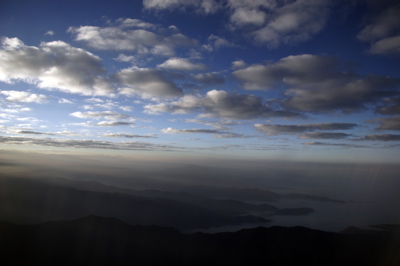
Once in Iquitos we drove around the city and boarded La Amatista, one of the ships that International Expeditions uses in its voyages along the Amazon.
La Amatista is a great 28 guests ship, perfect for the environment she lives in, and that carries a crew that easily becomes one of the highlights of the voyage. La Amatista, as all her sister ships, is build of wood, with an elegant design, and is fairly called by its crew the “cutest ship of the Amazon”
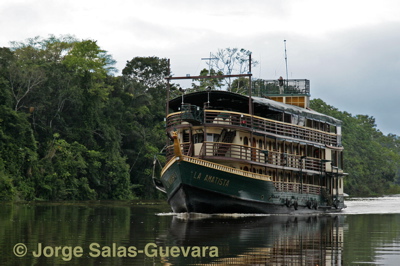
As soon as we walked into the ship we left the port, and in 15 to 20 minutes of navigating the Itaya River we entered the mighty Amazon. Leg one accomplished! The crew served pisco sours to celebrate and our Naturalists Guides, Yvonne and Roland, gave us a detailed but concise service and safety briefing.
After lunch (International Expeditions has arranged an exclusive upgraded program of meals for their ships, so food was very good) we had our first boat ride in search of wildlife (We came back with 22 birds in our species count) and everyone felt amazed by the views and sounds of the dense jungle and the live of the Riberenos, its human inhabitants.

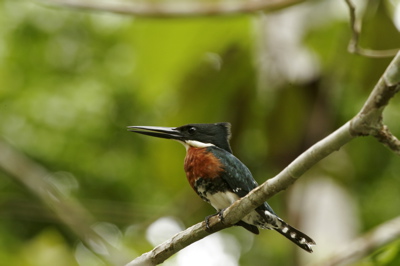
I was glad too, but I knew we where still close to the city. The next morning we would already be far away from civilization, closer to the Pacaya-Samiria creeks and to the opportunities for close wildlife encounters. It was time to charge batteries (Of the camera’s and mine)
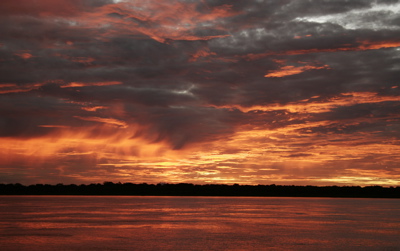
A warm and strong coffee while shooting the sunrise from La Amatista observation deck and we departed on the speedboats for an early birding excursion. It was amazing! We found a little creek that just got enough water to let us cruise it. Marsh Tyrants, Red-caped Cardinals, Russet Backed Oropendolas, Yellow-rumped Caciques, a variety of fly catchers, Ringed and Amazon Kingfishers, a couple of Woodpeckers (Creamed Coloured and Crimson-crested), Jabiru storks and two close encounters with Great Black Hawks. Fantastic.

We returned for breakfast and after a few minutes to freshen up, we departed to visit a local village. International Expeditions has the policy of not informing in advance the villages we visit, so we were able to observe their daily life without any “tourist” setup. The photo opportunities were just amazing and we had many chances to interact with the friendly locals (There are few people in the world as friendly, warm and cheerful as the Ribereños of the upper Amazon). Of course, the special moment was the visit to the school. It is a heart touching, beautiful experience.

The next few days we took the motorboats to explore several creeks, including El Dorado and Sapote, some of the best ones in the reserve. Wildlife was booming and we were very lucky to see it pretty close. Black collared hawks, horn screamers, Wattled Jacanas, Green Iguanas and squirrel monkeys were the most abundant species. Monk Saki Monkeys, Brown Capuchin Monkeys, Three toed Sloth, Chestnut-eared Aracaris, Blue and Yellow Macaws and Blue Morpho Butterflies were the highlights.
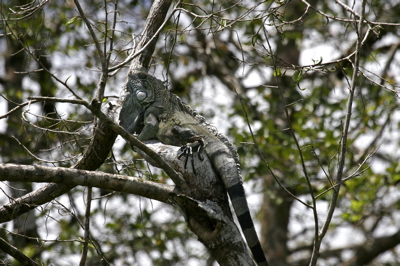
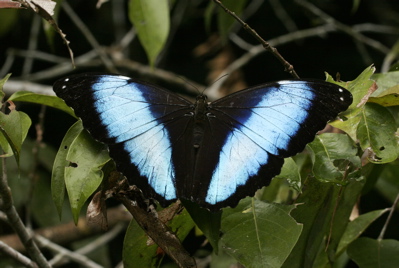
One of the mornings we found a flock of Oriole Blackbirds. There were more than 200 of them!
We spend one of the nights close to the mouth of the Sapote Creek, so we took the skiffs and found some dry land where we walked looking for night creatures. Only a few minutes after we started walking our Guides spotted a Pink Toed Tarantula and a Tailless Scorpion. Then, Roland made a sudden move close to the ground and rise with a beautiful 4 feet rainbow boa.
Our Naturalist Guides were just amazing. They are locals with an incredible amount of knowledge of the ecosystem they live in and the culture of their people. Their enthusiasm and constant effort to share information made of this a perfect voyage.
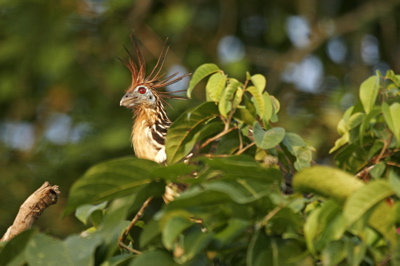
On Wednesday afternoon we arrived to Pacaya River and we received news that a big flock of Hoatzins was spotted one hour upriver, so we took the motorboats for a three-hour exploration of the Pacaya River. On our way we observed several Jabiru and Wood storks (the last ones to migrate). At 5:10pm, under a great light, we found some 20 hoatzins perched low on the bushes, almost at our eyelevel! It became a moment of photo frenzy until the deep, long and strong calls of the Red Howler monkeys freeze us. They were right there, on the other shore of the river, looking at us. All the cameras turned, while the light became even warmer, and the shooting continued. We stayed in that spot switching from hoatzins to howlers and from howlers to hoatzins until dark. Then we started to cruise, slowly, back to the mouth of the Pacaya, where La Amatista awaited for us.

We had no moon that night and the stars where magnificent. The Milky Way was as clear as it can get and after enjoying the immensity of the universe with the Amazon sounds as background music, we turned on the speedboat’s spotlight to look for night creatures. Very soon a pair of red points appeared close to the river edge, a White or Spectacle Caiman. We started to approach it and for some strange reason the reptile didn’t move. All the members of the group were able to see it in the water. It was a beautiful 6 feet specimen. Later that same night, Tui-Tui, our local wildlife spotter, caught a small one for a brief analysis.
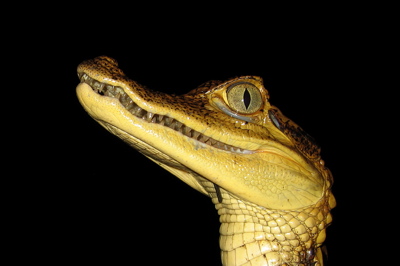
The next was the big day. We departed after breakfast to go as deep as possible into the Pacaya Samiria Reserve, to one of its most protected areas. We cruised fast the first leg and then reduced the speed as we reached the first lake. It was clear that we entered a unique sector. Many Yellow-spotted turtles were sunbathing over the logs the emerged from the black waters, more than 16 howler monkeys amazed us along the way and Pink River Dolphins appeared everywhere. The birdlife was amazingly prolific and the walk in the jungle that we enjoyed let us understand the complexity of the ecosystem we were exploring. Particularly interesting was the huge Kapok tree that we encountered.
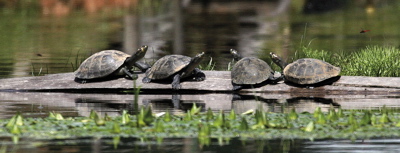
We were back aboard La Amatista by 2:30pm and immediately we started cruising the Ucayali River downstream, back towards Iquitos. Along the way we had other wildlife spotting excursions and, in a lake behind a village, we visited some beautiful wild giant water lilies. Yes, the biggest ones in the world.

As we approached Iquitos, the main city of the Peruvian Amazon, a beautiful sunset made us sigh, dreaming of the next time we would visit this wild and diverse wetland. The heart of the Amazon Basin.
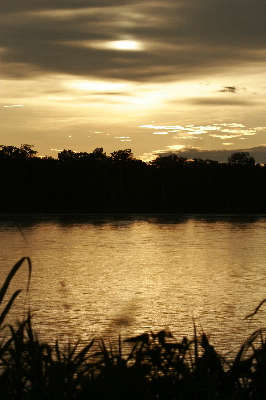
Expedition Results:
– Bird Count: 113 species
– Monkeys Count: 8 species
– Reptiles Count: 6 species
– Other Mammals: 7 species (Including a brief sight of Capybaras)
– Insects: Many, including tarantulas, butterflies (Many owl and Blue Morpho) and 4 ant species.
——————
Now that you read about this voyage (Or if you have been lucky to experience it as a traveler) don’t forget to visit this Blog often, I will be updating regularly the information on the river, its wildlife, its people, and will add information of the many species that inhabit it.
If you are interested in being a participant of the Voyage, contact International Expeditions (www.ietravel.com). There are high chances that we would meet there.
Thanks for stopping by. Please leave your comments and check our shop. It includes several products related to the Amazon.
Cheers,
Jorge
P.S. Since I am not a native English speaker, I don’t spec to manage perfectly the language, just good enough to share this information with my English-speaking friends. Please forgive any language aberrations. :0)
IMPORTANT NOTES:
This website does not represent any other than the personal opinion of the author.
Any of the photography, text, audio and video in this website cannot be reproduced without written permission from the author.
Please contact content@geowonders.com for further information.